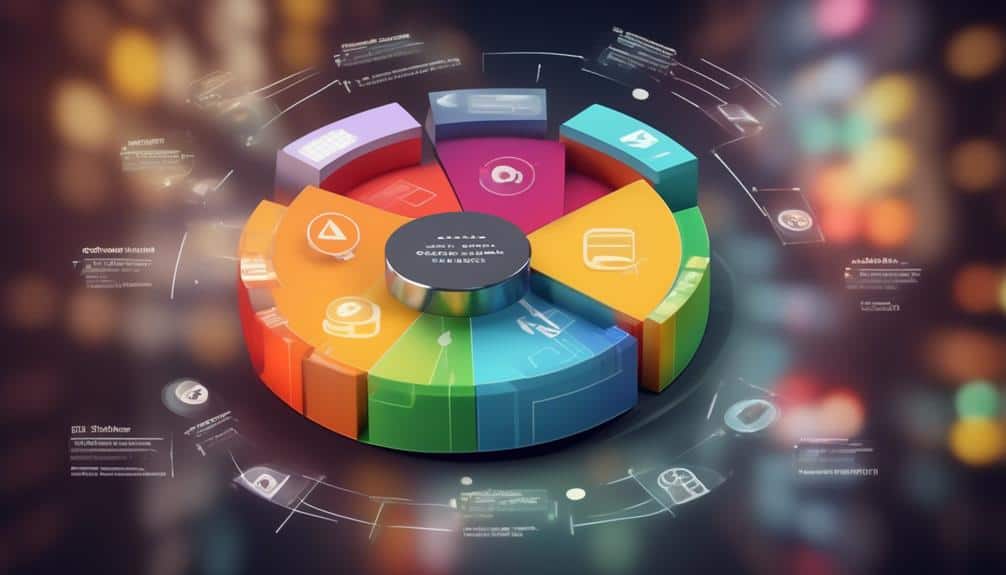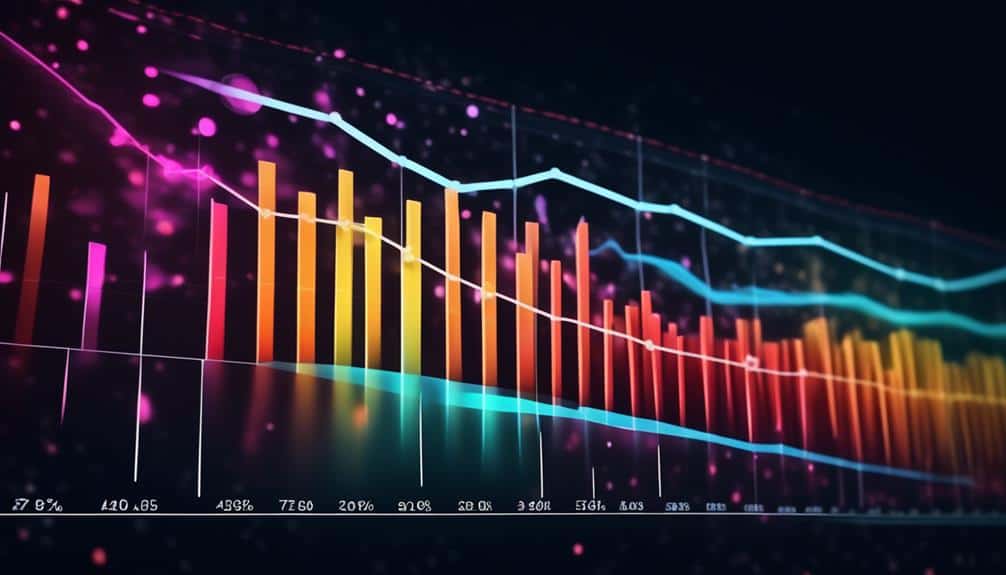Analyzing Success: Metrics That Matter in Content Promotion and Distribution
When it comes to evaluating the effectiveness of your content promotion and distribution efforts, you might be tempted to focus solely on vanity metrics like page views or social media likes. However, in the realm of digital marketing, success is not just about numbers; it's about the quality and impact of those numbers.
Understanding the right metrics to measure can provide invaluable insights into how well your content is resonating with your audience and driving real results. By honing in on specific key performance indicators (KPIs), you can gain a clearer picture of what strategies are truly working and where adjustments might be needed.
Key Takeaways
- Understand the origins of traffic to focus on organic growth and direct traffic, reflecting content resonance and brand loyalty respectively.
- Utilize Click-Through Rate (CTR) analysis for assessing content effectiveness and refining strategies to enhance user interaction and drive more traffic.
- Gauge content strategy success through Conversion Rate tracking, implementing A/B testing, mapping customer journeys, and streamlining conversion funnels for better results.
- Segment audience based on referral sources, personalize content for enhanced engagement, and tailor strategies to specific audience segments to improve targeting optimization.
Traffic Sources

To maximize your content's reach and engagement, understanding where your traffic originates from is crucial for optimizing your promotion strategy. Two key sources of traffic that you need to focus on are organic growth and direct traffic.
Organic growth refers to visitors who find your content through search engines or social media without any paid promotion. This type of traffic is valuable as it indicates that your content is resonating with your target audience and is being discovered through genuine interest.
Direct traffic, on the other hand, comes from visitors who type your website's URL directly into their browsers or click on a bookmarked link. This source of traffic is a strong indicator of brand loyalty and existing awareness of your content.
Click-Through Rate (CTR)
Understanding the Click-Through Rate (CTR) is essential for evaluating the effectiveness of your content promotion and distribution efforts. CTR measures the percentage of people who clicked on a link after seeing it, providing insights into the engagement level of your audience. By analyzing CTR data, you can refine your strategies to enhance user interaction and drive more traffic to your content.
Click-Through Rate (CTR) Analysis
| CTR Benchmarks | CTR Optimization Strategies | User Behavior Analysis |
|---|---|---|
| 2% – 5% | A/B Testing Headlines | Click Heatmaps |
| Compelling Call-to-Actions | Time on Page Analysis | |
| Optimizing Meta Descriptions | Scroll Depth Metrics | |
| Visual Content Enhancements | Exit Intent Pop-ups | |
| Mobile-Friendly Design | Conversion Funnel Analysis |
Conversion Rate

Analyzing your conversion rate is crucial in gauging the success of your content promotion and distribution strategies. Understanding how many of your visitors take the desired action provides valuable insights into the effectiveness of your content.
To delve deeper into this metric, consider the following:
- Conversion Optimization Strategies
- Implement A/B testing to refine your content and calls-to-action for optimal conversion rates.
- Utilize data-driven insights to continuously improve your conversion strategies.
- Customer Journey Analysis
- Map out the customer journey to identify potential bottlenecks or areas for improvement.
- Optimize the conversion funnel to streamline the path to conversion.
Engagement Metrics
Engage your audience effectively by tracking key metrics that measure their interaction with your content. Understanding user interactions and engagement analytics is crucial for optimizing your content strategy. By analyzing these metrics, you can gain valuable insights into how your audience is engaging with your content and tailor your approach for maximum impact.
Engagement Metrics Table:
| Metric | Description |
|---|---|
| Page Views | Total number of times a page has been viewed |
| Time on Page | Average time users spend on a page |
| Social Shares | Number of times content is shared on social media |
| Click-Through Rate | Percentage of users who click on a call-to-action |
Tracking user interactions like page views and time on page can help you gauge the level of interest your content generates. Additionally, monitoring social shares and click-through rates provides insights into how well your content resonates with your audience. Utilize these engagement metrics to refine your content strategy and drive meaningful results.
Social Sharing

When it comes to social sharing, you need to focus on creating shareable content strategies that resonate with your audience.
Collaborating with influencers can significantly impact the reach and engagement of your content.
Keep an eye on virality and engagement metrics to gauge the effectiveness of your social sharing efforts.
To enhance the shareability of your content, focus on crafting compelling narratives that resonate with your target audience's emotions and values. When aiming for content virality and shareable formats, consider the following strategies:
- Emotional Connection: Develop stories that evoke strong emotions like joy, surprise, or inspiration.
- Visual Appeal: Utilize eye-catching visuals, infographics, and videos to enhance engagement.
- Interactive Elements: Incorporate polls, quizzes, or interactive content to encourage participation and sharing.
Influencer Collaboration Impact
Crafting shareable content strategies is key, but amplifying their impact through influencer collaborations can significantly boost social sharing metrics. Influencer partnerships are a powerful way to extend your reach and engage with new audiences. By leveraging influencers' credibility and large followings, your content can gain more visibility and credibility.
Collaborative campaigns with influencers can drive authentic conversations around your brand, leading to increased social sharing and engagement. According to recent data, brands that engage in influencer collaborations see a 4.5x increase in social sharing compared to those that do not. This highlights the importance of integrating influencer marketing into your content distribution strategy to maximize social sharing metrics and overall campaign success.
Virality and Engagement
Leveraging the power of virality and engagement is crucial for maximizing social sharing metrics in content promotion and distribution strategies. To excel in this realm, consider the following:
- Viral Content Strategies: Implementing strategies like creating content that evokes strong emotions or utilizing trending topics can significantly increase virality.
- Engagement Tactics: Engage with your audience through interactive content, polls, and contests to boost engagement levels.
- Increasing Virality, Boosting Engagement: Encourage social sharing by incorporating share buttons, creating visually appealing content, and collaborating with influencers to expand reach.
These tactics not only enhance your content's visibility but also foster a loyal and interactive community around your brand. Embrace the power of virality and engagement to propel your content to new heights.
Referral Traffic

When evaluating your content's performance, understanding your traffic sources is crucial. Referral traffic can provide valuable insights into which external sites are driving visitors to your content.
Traffic Source Analysis
Analyze your website's referral traffic to uncover valuable insights into where your audience is coming from and how effective your external promotion efforts are. When diving into your traffic source analysis, consider the following:
- Traffic Source Trends: Identify patterns in where your traffic is originating from to optimize your promotional strategies.
- User Behavior: Understand how users from different referral sources interact with your content to tailor your marketing approach effectively.
- Competitive Analysis: Compare your referral traffic sources with competitors to identify areas for improvement.
- Audience Segmentation: Segment your audience based on referral sources to personalize content and enhance engagement.
Conversion Rate Tracking
To effectively track the conversion rates of your referral traffic, focus on analyzing the user journey from initial click to desired action. Understanding user behavior and optimizing for conversions are essential in maximizing the effectiveness of your content distribution efforts. Utilizing A/B testing can provide valuable insights into what drives conversions within the customer journey. By experimenting with different elements and analyzing the results, you can refine your strategies for better outcomes. Below is a table highlighting the importance of conversion rate tracking in referral traffic:
| Metric | Description | Importance |
|---|---|---|
| Conversion Rate | Percentage of visitors who take action | Measure of effectiveness |
| Referral Source | Where the traffic is coming from | Targeting optimization |
| Bounce Rate | Percentage of single-page visits | Engagement assessment |
| Click-Through Rate | Percentage of clicks on a link | Ad performance |
Time on Page
Understanding how long visitors spend on a webpage can provide valuable insights into their engagement with your content. Time on Page, also known as engagement duration, is a critical metric that reflects user interaction and content relevance.
Here are some key points to consider:
- User Engagement: Time on Page indicates how deeply visitors are interacting with your content. The longer the duration, the more likely they're to be engaged and find value in the information presented.
- Content Relevance: Monitoring Time on Page helps gauge the relevance of your content to the audience. If users are spending minimal time on a page, it may suggest that the content isn't meeting their expectations or needs.
- Content Retention: A longer Time on Page often correlates with better content retention. When users spend more time digesting the material, they're more likely to remember and act upon the information provided.
Bounce Rate

When visitors land on your webpage and leave without interacting further, their immediate exit contributes to the Bounce Rate metric. Bounce Rate measures the percentage of single-page visits to your site, indicating how engaging your content is to users. A high Bounce Rate can suggest issues with user experience or content relevance, leading to missed opportunities for conversion.
To improve Bounce Rate, focus on enhancing user experience. Ensure that your website is easy to navigate, visually appealing, and mobile-friendly. Engage visitors with compelling content that matches their expectations and provides value. Analyze bounce rates for different pages to pinpoint areas needing improvement.
Content relevance is key to reducing bounce rates. Tailor your content to match the intent of your target audience. Use clear headlines, engaging visuals, and relevant keywords to capture and retain visitors' interest. Regularly update and optimize your content to ensure its continued relevance and appeal to users.
Return on Investment (ROI)
Improving your Bounce Rate can lead to a deeper understanding of your Return on Investment (ROI) in content promotion and distribution. When delving into Investment analysis, focusing on ROI optimization is key for maximizing returns. Here's how you can enhance your ROI through strategic Marketing strategies:
- Leverage Data Insights: Utilize analytics tools to track content performance and identify high-performing assets. By understanding what resonates with your audience, you can allocate resources more efficiently, boosting ROI.
- Enhance Content Distribution: Implement targeted distribution channels to reach the right audience segments. Tailoring content delivery based on demographic data and user behavior can significantly impact ROI by increasing engagement and conversions.
- Optimize Conversion Paths: Streamline the user journey from content consumption to conversion. A smooth transition with clear calls-to-action can improve ROI by guiding users towards desired actions effectively. By optimizing these pathways, you can enhance the overall ROI of your content promotion efforts.
Frequently Asked Questions
How Does the Content Promotion Strategy Change for Different Target Audiences?
When tailoring content promotion for diverse audiences, utilize personalization techniques like audience segmentation. By customizing messaging based on demographics, interests, and behaviors, you can effectively engage different target groups and drive successful outcomes.
What Role Does Influencer Marketing Play in Content Distribution Success?
Influencer collaborations are key for content distribution success. Targeted outreach through influential figures can amplify your message to a wider audience, increasing engagement and reach. Utilize data-driven strategies to maximize the impact of these partnerships.
How Does the Timing of Content Promotion Impact Its Overall Success?
Timing optimization is crucial for content success. By analyzing engagement patterns, you can identify peak periods to promote your content. This strategic approach maximizes visibility and audience interaction, leading to higher impact and reach.
What Are Some Innovative Ways to Measure the Impact of Content Distribution Beyond Traditional Metrics?
To measure the impact of content distribution beyond traditional metrics, consider innovative approaches like engagement analysis and conversion tracking. These methods provide deeper insights into audience interactions and conversion rates, enhancing your understanding of content performance.
How Can A/B Testing Be Utilized to Optimize Content Promotion Strategies?
To optimize your content promotion strategies, utilize A/B testing. Experiment with different approaches to determine what drives conversion rates. Analyze the data to inform your decisions and continuously optimize for better results.
Conclusion
You now have the tools to measure the success of your content promotion and distribution efforts.
By focusing on key metrics like traffic sources, CTR, conversion rate, engagement metrics, social sharing, referral traffic, time on page, bounce rate, and ROI, you can make informed decisions to optimize your strategy.
Remember to continuously track and analyze these metrics to drive your content to new heights of success.
Keep up the great work!







